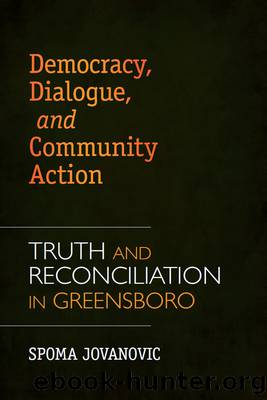Democracy, Dialogue, and Community Action by Jovanovic Spoma;

Author:Jovanovic, Spoma; [Jovanovic, Spoma]
Language: eng
Format: epub
Tags: Nonfiction
ISBN: 2007827
Publisher: University of Arkansas Press
Published: 2012-10-15T00:00:00+00:00
Even though they found inadequacy in police operations, the truth commissioners noted a number of more positive efforts that were launched in the aftermath of November 3 as part of a damage-control strategy.
For instance, the City of Greensboro released its opposition in 1982 to a district system for city elections to provide greater opportunity for minority representation on the city council. Another change was made in the cityâs budget to more equitably distribute resources across the quadrants of Greensboro, providing renewed funds to the black areas of the city. Finally, attempts at dialogue about race and among races were started and continued with support from the cityâs coffers for public events and employee training.
The positive changes were acknowledged, but the truth commissioners concluded that fear and distrust remained high among many segments of the community in Greensboro. The commissioners noted that the criticisms waged in 1979 against local government policies remained so in the twenty-first century as the activities of the Truth and Reconciliation Commission were launched. As evidence, they pointed to the excessive police force bordering on intimidation that was used when the twenty-fifth anniversary events for November 3 included plans for a march. To the truth commissioners, Greensboro in 2004 was acting as it had in 1979 where only one of two options seemed plausible for parade securityâabsence or intimidating overkill (Final Report, 2006, 250)ârather than thoughtful and cooperatively planned protection.
There were more incidents as well that pointed to the opposition of the community leaders and officials to embrace the community-grown effort for truth and reconciliation. For example, in advance of the Truth Commissionâs first public hearing, information was leaked to the press by someone in the police department, the city council, or the city managerâs office that Klansman Virgil Griffin was to speak. This act jeopardized Griffinâs participation since he had agreed to speak on the condition that his appearance not be announced in advance in order to prevent protestors and press from clamoring. The city council claimed that Griffinâs appearance could put the city in danger, an announcement the truth commissioners saw as a tactic to incite fear and keep citizens away from the proceedings.
Later, a Community Dialogue hosted by the TRC upon the completion of the three public hearings was held at Mount Zion Baptist Church. Police officials met in advance with church representatives but failed to include TRC staff in the discussions, citing that as an oversight. Some prospective statement givers and community dialogue participants reported they were discouraged by local officials from participating.
The truth commissioners concluded that the TRCâs activities were indeed relevant, important, and for some, even threatening. Attempts to suppress the TRC process included secret meetings, innuendos, intimidation tactics, deliberate efforts to mislead the public, and even a break-in at the TRC offices where file cabinets containing research, financial, and personnel files were ransacked. Rumors circulated and were repeated by some community leaders alleging the commissionâs operation was only possible because of âoutsiders,â that there was a less than autonomous relationship
Download
This site does not store any files on its server. We only index and link to content provided by other sites. Please contact the content providers to delete copyright contents if any and email us, we'll remove relevant links or contents immediately.
Cecilia; Or, Memoirs of an Heiress — Volume 1 by Fanny Burney(32022)
Cecilia; Or, Memoirs of an Heiress — Volume 3 by Fanny Burney(31436)
Cecilia; Or, Memoirs of an Heiress — Volume 2 by Fanny Burney(31380)
The Great Music City by Andrea Baker(30638)
We're Going to Need More Wine by Gabrielle Union(18604)
All the Missing Girls by Megan Miranda(14579)
Pimp by Iceberg Slim(13717)
Bombshells: Glamour Girls of a Lifetime by Sullivan Steve(13663)
Fifty Shades Freed by E L James(12885)
Talking to Strangers by Malcolm Gladwell(12812)
Norse Mythology by Gaiman Neil(12779)
For the Love of Europe by Rick Steves(11331)
Crazy Rich Asians by Kevin Kwan(8860)
Mindhunter: Inside the FBI's Elite Serial Crime Unit by John E. Douglas & Mark Olshaker(8662)
The Lost Art of Listening by Michael P. Nichols(7124)
Enlightenment Now: The Case for Reason, Science, Humanism, and Progress by Steven Pinker(6852)
The Four Agreements by Don Miguel Ruiz(6282)
Bad Blood by John Carreyrou(6252)
Weapons of Math Destruction by Cathy O'Neil(5798)
